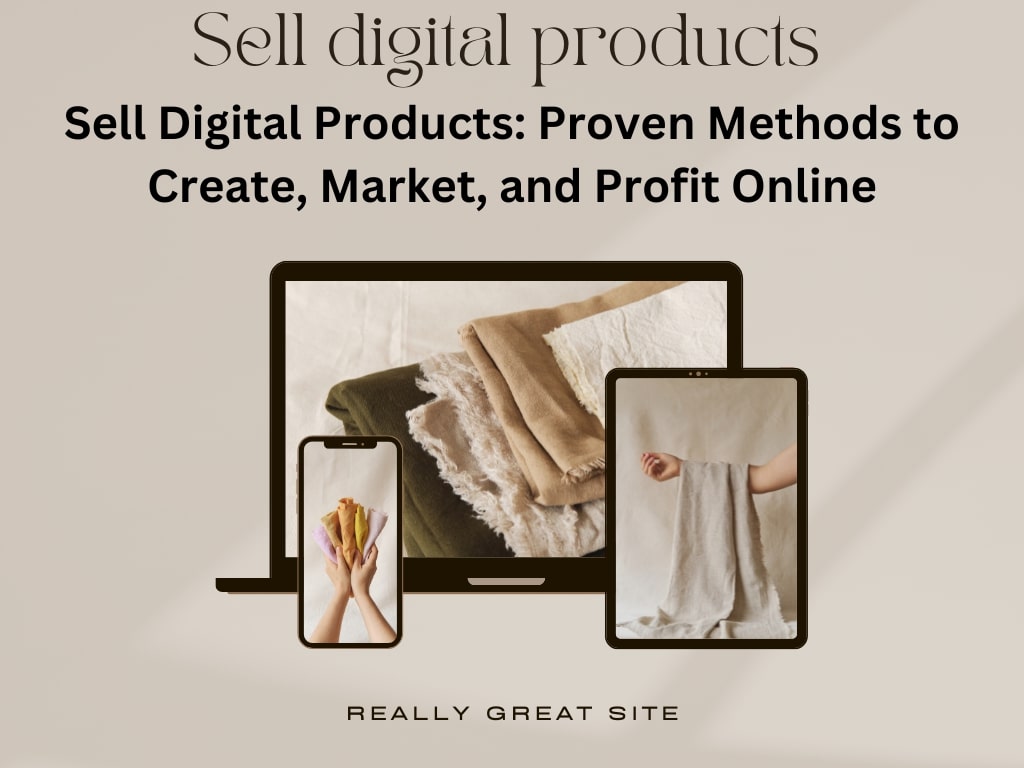Introduction
Selling digital products is one of the most lucrative ways to build an online business. Whether you’re an entrepreneur, a creative professional, or someone with specialized knowledge, digital products offer infinite possibilities for growth and financial freedom. In this comprehensive guide, we’ll show you how to create, market, and profit from digital products. Ready to turn your ideas into income? Let’s dive in! Sell digital products.
What Are Digital Products?
Digital products are non-physical items that can be created, promoted, and delivered entirely online.
Examples include:
• E-books: Convey your expertise or narrate a compelling tale.
• Online Courses: Teach a skill or provide valuable education.
• Templates: Business templates, creative assets, or productivity tools.
• Software: Apps, plugins, or SaaS tools.
• Digital Art: Stock photos, illustrations, or music files.
These products are scalable and cost-effective, making them ideal for anyone looking to start an online business.
Why Sell Digital Products?
Low Startup Costs
One of the main benefits of selling digital products is the low startup cost.Unlike tangible products, there’s no need to manage stock, handle shipping, or worry about physical storage. Once your product is created, it can be sold infinitely without the need for additional resources.
High Profit Margins
With minimal ongoing expenses, the majority of your revenue comes as profit. After the initial effort in product creation, you can sell your products over and over without worrying about material or shipping costs.
Scalability
Digital products can be sold globally, reaching customers anywhere in the world without limits on production. Whether you sell one copy or one thousand, the process remains the same, making it easy to scale your business.
Passive Income Potential
Once your digital product is live, it can generate recurring income with minimal effort. By automating sales through platforms like Gum road or Shopify, you can continue earning money while focusing on other tasks.
Step 1: Choose the Best Digital Product to Sell
Identifying the right digital product to sell is the first step towards creating a profitable business.
Solve a Problem
The most successful products are those that address a particular need or fulfill a specific demand. Consider your target audience and think about the challenges they face. For example:
• Busy professionals might need time-saving templates.
• Aspiring photographers could benefit from presets or editing tools.
Play to Your Strengths
Leverage your skills and passions. If you’re a designer, you can sell digital art or templates. If you’re an expert in a particular field, consider creating an online course or e-book.
Research Market Demand
Using tools like Google Trends and keyword research tools, you can find out what people are searching for. Identifying topics with existing demand ensures you’re targeting a market that’s already interested in your product.
Step 2: How to Create High-Quality Digital Products
Creating high-quality products is essential for standing out in the competitive digital marketplace. Here’s how to create products that your audience will love:
Use Professional Tools
Invest in quality software to create your digital products. Some popular tools include:
• Canva: For designing templates and social media graphics.
• Adobe Creative Suite: For high-end photo and graphic design.
• Screen Recording Software: For creating video courses.
Test Your Product
Before launching, ask beta testers for feedback. Their insights can help you identify any issues and improve the quality of your product.
Add Value
Ensure your product offers real value. For example, bundling multiple items together can increase perceived value and boost sales.
Step 3: Select the Right Platform for Selling Digital Products
Choosing the right platform is crucial to your success. Here are a few options depending on the type of product you’re selling:
- Etsy is great for printable products, templates, and digital art, offering access to a pre-existing group of potential customers.
- Gumroad is perfect for selling e-books, online courses, or artwork with an easy-to-use interface and email marketing integration.
- Shopify offers a customizable solution for those who want complete control over their online store.
- Teachable is a specialized platform for selling online courses.
- Your Own Website allows you to sell digital products directly, using tools like WooCommerce or Easy Digital Downloads for full control.
Step 4: Market Your Digital Products for Maximum Reach
Effective marketing is essential for success. Here are strategies to boost your sales:
- Optimize for SEO: Implement SEO strategies to increase the visibility of your product pages. Include keywords like “Sell digital products” in your product descriptions, titles, and content. Also, consider writing blog posts or articles that target related search queries.
- Leverage Social Media: Platforms such as Instagram, Pinterest, and LinkedIn work well for visual products. Share demos, behind-the-scenes content, and customer testimonials to attract attention.
- Build an Email List: Offer a free gift or discount in exchange for email sign-ups. Use your list to notify subscribers about new products, sales, or exclusive offers.
- Use Paid Ads: Paid advertisements can expand your reach. Google Ads, Facebook Ads, and Pinterest Ads are excellent for targeting specific demographics.
Step 5: Protect Your Digital Products from Piracy
Since digital products are more prone to piracy than physical products, it’s important to take protective measures:
- Use Licensing Tools: Platforms like Gum road and Send Owl offer built-in licensing tools that generate unique download links and prevent unauthorized sharing.
- Add Watermarks: If you’re selling digital art, consider adding watermarks to your previews to protect against unauthorized use.
- Monitor Piracy: Set up Google Alerts to track unauthorized distribution. Taking quick action can help minimize losses.
Step 6: Scale Your Digital Product Business for Long-Term Growth
Once you’ve established your business, it’s time to scale. Here’s how:
- Expand Your Product Line: Consider offering complementary products or bundling items for a discounted price to increase your average order value.
- Collaborate with Affiliates: Partner with influencers or bloggers who can help promote your products. An affiliate program can greatly extend your reach.
- Improve Your Marketing: Continuously optimize your SEO, email campaigns, and paid ads. Test different strategies to find what works best for your audience.
Conclusion
Selling digital products is a profitable and scalable business model that offers unlimited growth potential. With low startup costs, high-profit margins, and the ability to reach global customers, digital products are perfect for entrepreneurs seeking long-term success. By following the steps outlined—choosing the right product, creating high-quality content, marketing effectively, and protecting your products—you can turn your ideas into a sustainable and thriving business.







